Wade and I just returned from an absolutely incredible trip in Peru, stopping in Boston for a quick 20 hours before joining his family on their vacation in San Diego for a few days. Getting the chance to fully re-set and recharge my batteries? Glorious. Not checking email for two weeks? Terrifying (and glorious).

Loved the sun and sand time!

Even better than the beach? Time with Wade and his family!
I’ve had so many people reach out with questions about the trip that I wanted to write a little guide, a rundown of the places we saw and what the Salkantay trek from Cusco to Machu Picchu was like. Then I realized that “a little guide” just wasn’t going to cut it…I like to talk way too much to keep this short. So without further rambling, here’s part one of our trip to Peru!

The goal? Machu Picchu!
First off, the planning. Once we decided that we really wanted to see Machu Picchu and hike through the Andes mountains in Peru, we weren’t sure exactly how to plan the details! We decided to plan our trip through Global Basecamps, and they were truly awesome. Could we have set this trip up ourselves? Probably, but we had a lot of questions about the area, had no idea what to expect for the weather or how to pack when going through 16 climate zones on our planned hiking route, don’t speak Spanish fluently, and didn’t want to be stressed out about the details. We just wanted to enjoy our trip! As soon as we reached out to them they were incredibly helpful and answered all our questions, then helped us plan the trip so we could make the most out of the time we had, and see everything we hoped to see! We didn’t have to worry about setting up taxis (there are a lot of warnings in the airport about taxi scams), booking a good hotel right near the old part of town, or renting good camping gear. Perhaps most importantly, they work with local tour groups and set us up with the most incredible guide, Cesar, who really made the experience an incredible one for us. I’d definitely recommend going through them if you are looking to plan a trip. If you’d like to see more about them, here’s the LINK to their website!

Thanks to Global Basecamps for helping us find the most incredible guide, Cesar!
A note about travel: I can’t lie to you, it’s probably going to be a long series of flights. But it’s absolutely worth it, I promise! But here’s a little tip to hopefully make your travel day easier than ours was. I take great care to only recommend brands, companies and experiences that I truly believe are good, and I don’t want to lead anyone astray. For that reason I can’t in good conscience recommend that you fly Air Canada, as we had some pretty rough experiences with them and watched as way too many people were denied boarding our last flight back to Boston due to them overselling the seats. But luckily there’s a lot of options to get down to Peru, and once you’re there you don’t have to deal with jet lag from the time change, which is a really nice bonus.

The Plaza de Armas, the main square in Cusco. The flag of Peru is on the left, the rainbow flag on the right representing Cusco.
We started our trip with a day in Cusco, to explore and basically eat all the ceviche we could find. We were traveling over Easter week, so when we left our hotel to go walk around town we saw hundreds of people out on the steps of the church for Palm Sunday. Every ten feet, ladies were selling sweet empanadas and dulce de leche tamales (both were tasty) and the main square, Plaza de Armas, was packed with families, both tourist and local, enjoying the warm weather. I learned that a knowing a few words in Spanish was very helpful (thanks, grade school and junior high Spanish classes!). Beyond the usual “please and thank you”, it was especially handy when asking “where’s the restaurant with the best ceviche?”, “where is the toilet, please”, or understanding how many soles the man in the market was asking for the red sweater with the llamas on it.

Families enjoying the sunshine in the square!
If you have a day in Cusco, here’s your need to know:
-Try the street food! If you’re nervous about it, start with the sweets; churros, sweet empanadas and sweet tamales were pretty outstanding.

Yum!
-Walk around both the open air and covered markets, and whatever you do, definitely sit at one of the juice counters and try their fruit juice. They will peel the fruit right in front of you and blend it up, no water added…and it’s incredible.

One of about 20 juice counters lined up in the markets.
-While you’re at the markets, check out all the adorable sweaters that scream “I’m a TOURIST!” It’s ok, just embrace it. You ARE a tourist. Don’t fight it. You can get more expensive sweaters that are made from 100% baby alpaca (meaning the first time they cut their hair, so it’s the softest and not as wiry or itchy), although most of what you’ll find in the markets is a blend, and they’re incredibly cheap.

You’re a tourist. So what? Embrace it!
-Besides the art you see woven into sweaters and blankets, there are many other mediums of art all over the city! Wade and I loved walking around looking at the local artists beautiful creations, and I’d recommend taking the extra few minutes to poke your head into the tiny shops tucked into the walls, because you can find some beautiful things hidden there!

Exploring the outside of a Spanish church in Cusco
-Being fueled by tourism, many places accept credit cards. If they don’t, they are within walking distance of an ATM.

Flowers on flowers! Probably a good idea to have cash (soles) on hand for most market items.
-Oh my gosh, don’t even get me started on the food. We literally couldn’t find a bad place to eat there. Every place we tried, the food was so fresh and delicious! For more Peruvian food, try Limo or Ceviche, both located in the main square of Plaza de Armas. For food that’s definitely catering to tourists but with a fun and fresh Peruvian twist, go to Jack’s (bring cash, they don’t take cards) or Pacha Papas.

Quinoa finds its way into most dishes, and it’s delicious.
And can we talk about the fact that we were walking around the Andes mountains chewing cocaine leaves? Relax, it’s ok. Technically, we were chewing coca leaves, the plant that cocaine is made from, but in it’s raw form without being chemically altered the human body can’t absorb the cocaine. You can (and do) absorb about 4 cups of coffee worth of caffeine, though! We learned that after a big breakfast, farmers in the area go to work all day with just a bunch of these coca leaves for energy. Whoa!
Coca are used to help with altitude sickness as well, all the locals told us. I mean…”when in Rome”, right? We tried the coca tea, and later tried chewing the leaves plain. In case you’re wondering, it tasted somewhat like green tea. Despite this, Wade had a headache our first night in Cusco, which makes sense given that it’s at 9,000 feet. What we didn’t know was that this altitude headache would be a warning for later….cue the dramatic and foreboding music!

Just another beautiful church in Cusco…you tired of these yet?
Our second day in Cusco we drove to some incredible Inca ruins only 20 minutes out of town, called (you’re going to love this): Sacsayhuaman, pronounced “sac-saaaaaay-whoooooomaaaaan”. Or, if you’re really not going to try the accent, “sexy woman”. The stonework of the Incas was truly awe-inspiring, especially when we learned that the stone used in Sacsayhuaman had been moved there from over 10 kilometers away. These huge rocks were rolled into place and slowly chipped away until they fit together so tight, you couldn’t even slide a piece of paper in between them!
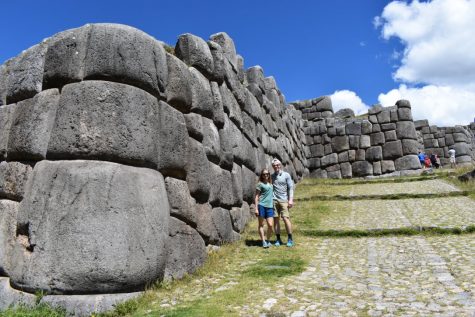
Those are some HUGE rocks! Wow! Wade and I in Sacsayhuaman.
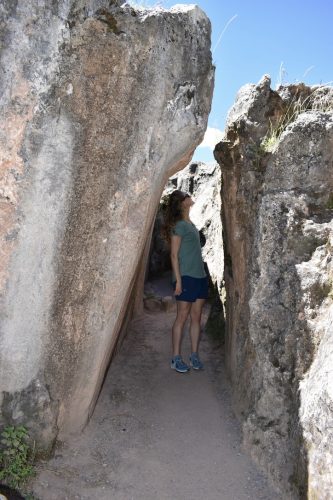
Going into one of the ruins
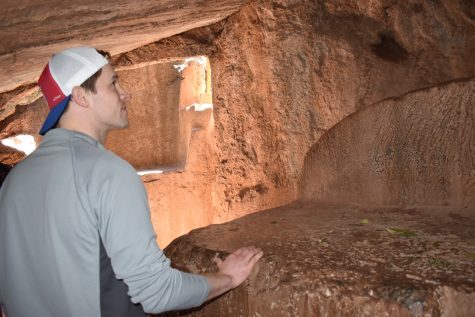
This was where they may have made some of the mummies of the Inca royalty when they died. So cool, so creepy, all at the same time!
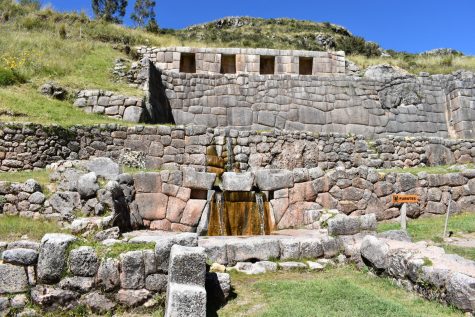
The windows at the top, where the stonework is finest, were for the Sun God.
They’ve withstood earthquakes that took the colonizing Spanish’s churches to the ground, but these Inca walls are still standing, in the ruins outside the city but also spread out throughout Cusco as well. When the Spanish came in, they destroyed or converted to Catholic churches much of the Inca’s work, but built right overtop of some of it. So as you’re walking around town, you’ll see a section of Inca wall or a few stones built into a house.

Hiding in plain sight…Inca stonework!

Look at the rock to the right of Wade – it’s touching 12 other rocks. Imagine fitting those together with only other rocks as tools! Wow!
That night was the “Lord of the Earthquake” celebration in Cusco. We had quickly learned that the overwhelming majority of Cusco is Catholic, and this was a very important week for them. But nothing was more important than this celebration, to honor the earthquake Lord, as the people there were Catholic but (as it was explained to us) still believed in the forces of nature and needed to respect them. The Plaza de Armas filled with people as the evening turned into night and people pressed close to see a glimpse of the flashing tall red figure, the solitary Lord in the parade, as it moved about an inch per minute through the streets of town. Wade and I had dinner in a balcony to watch the entire thing and it was so special to see what was clearly a very important part of the Quechua culture! Then we got to bed early because the next day, the trek I’d been so excited for was about to begin.

That’s a lot of people!

Wade and I enjoying the Lord of the Earthquake festivities.
A note about our hike: we had decided that since this was a vacation, after all, and we didn’t know anything about the Andes mountains, we’d go on a guided hike. This meant that porters bring the camping equipment, food and clean water for you on a horse and you only have to hike with a day pack. I would highly recommend this. While it’s also fun and a cool adventure to bring everything totally by yourself, I could see where hiking at 15,000 feet of altitude with a 40lb pack and not getting to learn any cool facts about the area you’re exploring would sort of…well…not really feel like much of a vacation! By going with a guided tour, we were able to learn more and stress less. As it turned out, we were the only two booked for this specific tour at this time of year, so we lucked out with a private tour!

One cool thing we learned from Cesar was that if a doorway was incredibly tall, like this one, it was for Incas – the royal people, who would be carried in on a litter. The Quechua people had regular sized doorways and houses.
Our first day of the Salkantay trek began at 6am. I would later learn that nearly every day would begin this early, because by 6am it was light outside and by 6pm it was fairly dark, so by waking up around 5-5:30 and starting each day’s hike early, you’d avoid a lot of the hot sun and be able to really take your time and enjoy each moment of the hike. This was, after all, a vacation…not a training camp! It was really fun to hike at a leisurely pace that was enjoyable, and although it was still challenging to be hiking over a 15,000 ft pass, we weren’t in a hurry to get anywhere!

I learned how to be a morning person. Haha!
We met our guide, Cesar, the chef for our hike and one of the porters at the hotel and drove for three hours through small towns, stopping at Limbatambo for a quick breakfast. Everywhere you looked, there were tiny taxis on three wheels. When I looked closer, I noticed the taxi cab was actually a little bench seat attached to the back of a motorcycle, with a loose frame holding it all together. The driver was essentially just riding a motorcycle inside a car frame. No lack of creativity there!
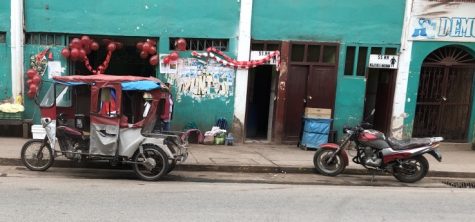
Check this out: a motorcycle-taxi cab.
After driving up into the mountains, we followed a bumpy dirt road to the grassy flats at the foot of the ice-covered Humantay mountain, an area called Soraypampa, which is where the trail began. This was where we met the other two porters for our trip, who were in charge of the horses that carried the food, water and gear. Everyone was incredibly nice, and although I could only string together a few words in Spanish and talked like a 2 year old trying to learn how to conjugate verbs, they were patient and friendly and let me try to practice my Spanish with them!

The horses that were so helpful in carrying our gear for us!
A note on these totally awesome, badass porters…I loved going through Global Basecamps because they partner with tour companies that treat the porters extremely well and compensate them fairly. These guys, combined with Cesar’s knowledge and expertise, friendly company and fun facts about not only the archeological ruins but the various birds and plants we saw along the way, totally made the trip for us. I was stunned by how hard-working and tough these guys were in the mountain weather, however, when I learned that after the four day trip, they wake up early the next morning and hike it all the way back to the start in ONE day, where they rest for a day before helping the next hiking group. It seems like the people of the Andes Mountain range are just tougher and more badass than most other people on earth, in pretty much every way! They were impervious to the weather conditions, cheerful in cold rain with no complains when it was hot and humid. They could hike faster than anyone even at 15,000 feet, and knew their way around the cloud forest and high mountain ranges. I like to think I’m in pretty good shape, but if I asked the porters how many hours the hike was, I had to tack on an extra hour for how long it would actually take me to hike it. I know that shirtless cross country skier dude from Tonga gets a lot of attention at the Winter Olympics, but let me tell you…I’d love to get some of these guys and their incredible aerobic capacity on skis!

Some porters from another group saying hi!
Once we got hiking, we started slowing winding our way uphill along the same trail that goes to the Humantay mountain glacier before they split up. Up ahead you could see different tour groups beginning their hikes, and various eco-lodges where hikers not sleeping in tents could spend the night. I would later learn that the term “pampa” referred to a flat area, which is why pretty much anywhere we would be camping would end in “pampa”.

Local families had houses along the way and sold sweaters or food to hiking groups.
We only hiked about an hour and a half uphill that day to Salkantaypampa, which wasn’t a village, but the name for the flat area at the base of the steeper climb up to the Salkantay pass, with a beautiful and imposing view of the ice-crusted south face of Salkantay looming up above us when the fog cleared out.

The clouds started to clear and gave us a view of the south face of Salkantay from our campsite.
We stopped there because it had started to rain pretty hard and the flatter areas for camping up high were flooding out. This ended up being a huge bonus, because at this point we were at 13,500 feet of elevation, which was, you know, just sliiiightly higher than Boston’s sea level air. In fact, it’s the same altitude at which the pilot informed us that we were beginning our decent into Boston on our flight home. Skyjumpers jump out of planes much lower than that. I’m just saying.
Wade had worried that the altitude might pose a potential threat to our trip, but I had brushed it off, saying “it’s nothing! It’s not THAT high!”. Whoops. In a strangely prophetic turn of events, I wasn’t affected at all by the altitude. Which is crazy, because I definitely notice even 5,000 feet when I’m in training camps. Maybe the lack of needing to perform or feel good meant that I just didn’t notice if I wasn’t feeling 100%, but either way, I wasn’t affected by altitude the entire trip. Wade, on the other hand, got hit hard by altitude sickness the moment we drove over 12,000 feet before we even began hiking. I felt horrible, because it looked pretty miserable, and we were both worried that the trip would be ending soon for him, as it was pretty debilitating. He described it as the pounding headache of a concussion combined with the body ache and nausea of the flu. Luckily, our guide Cesar had been through this hike a time or two, and had pretty much seen it all. They traveled with an emergency tank of oxygen and after a few minutes of breathing more “sea-level air”, Wade felt a little better. I’m not going to lie, that first 30 hours of the hike were rough for him, until we had gone over the pass and defended back down to around 8,000 ft. As it turns out, you can’t predict who will be hit by altitude sickness, or when! But as soon as we got down to easier breathing, Wade was fully back to normal and totally fine. What sort of sorcery is this altitude thing, anyways? Huh? My point here is, don’t miss out on a crazy cool experience like this for fear of altitude sickness unless you already know you are severely affected by it. Wade had an awesome trip as soon as we got lower in altitude, and even when he was in a rough spot he was able to enjoy the scenery and impressive face of Salkantay Mountain.

Even when he was hit hard by the altitude, Wade still had a smile for me!
But back to our camping spot…we made it to the flat area where the porters had already set up our tent, which was incredibly nice as we were both pretty cold and Wade already had a headache from the altitude. However, once the rain cleared up I got out to walk around and it was absolutely gorgeous! The wisps of clouds constantly curling and circling the mountains on either side of us made it feel surreal and (at the risk of sounding totally cheesy) magical.

Our campsite for the first night is at the bottom of the mountain.

Happy that I packed a warmer layer of clothes and rain gear!
Speaking of magic, it was amazing to me what our chef could conjure up in a tent with a pan, a pressure cooker pot, a gas stove and a cutting board that he placed across his knees to chop up vegetables! The food we had every day on this trip was out of this world. Fried garlic bread and vegetable soup, spiced potatoes, quinoa and pan-seared fish, purple corn jelly for dessert…it was both cool and tasty to experience local and traditional foods from the Andes mountains.

Our chef for the hike, working his culinary magic!
The next morning, we got up around 5:30 and after another tasty breakfast (my favorite breakfast of the trip was a quinoa porridge mixed with spices and bananas), packed up and started up towards the Salkantay pass. Wade had a pounding headache and nausea still from altitude sickness (sleeping at 13,500 probably didn’t help this out!) so for that morning he went on horseback, to get up and over the pass and down towards more oxygen as quickly as possible. I followed at a more stop-and-take-all-the-photos pace, and loved every second of the snow capped peaks surrounding us.

Made it up the first steep part of the climb that morning!
Salkantay peak was at a staggering 20,570 ft, but the pass we went over topped out at 15,300 so even as we were looking down at mountains and valleys below us, we were still dwarfed by the imposing Salkantay.

The trail on the left winding up towards the pass.
At the top of the pass, little rock figures were everywhere with coca leaves snugly tucked into the base of them, as offerings to Pachamama, mother earth. I loved how connected to the planet the Quechua people are, and this is probably obvious but whenever we left a campsite, there was no trace that we had been there at all, preserving the beauty of the mountains and the plants of the cloud forest.

Little offerings to Pachamama everywhere.
We were incredibly lucky with the weather this entire trip, especially as in April we were just at the end of their rainy season, and it was impossible to predict weather in the Andes. This bright and sunny morning, however, the clouds completely cleared out for the hour and a half that we were nearing the top of the pass, and we were granted an incredible view down either side of the mountain. Later when we were a few thousand feet down, we looked back up and saw that the pass was completely obscured in fog once again. I’d never been so happy about a 5:30am start to the day before!

Wade and I enjoying a moment at the top!
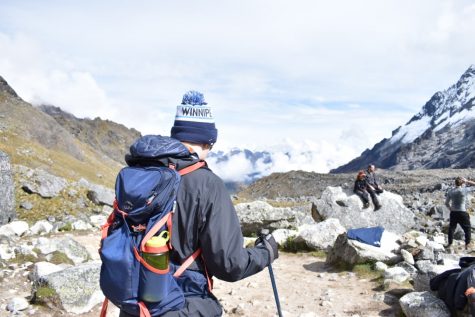
Wade starting the hike down towards the cloud forest.

Sunscreen, sunscreen, sunscreen – I cannot say this enough for the top of the pass!
After descending for a few hours we stopped for lunch right at the edge of where the cloud forest began. Fog and clouds were constantly blowing up over the rim of the steep drop down, and the area truly lived up to its name with clouds bringing small rain showers, followed by hot sun, followed by fog and clouds and back to sun again in a manner of minutes. I’ve traveled to a lot of places, and it’s funny to me how in almost every place, a local will jokingly tell me “you know, we have a saying about the weather here! If you don’t like it…wait 5 minutes!” The only people who never made this claim were, perhaps, the only people who truly should have – the Quechua people of the Andes mountains. Never before have I seen such truly ever-changing weather as in the cloud forest, and it was beautiful!

As we hiked down from the pass, we started seeing little potato farms! Up above, Salkantay starts to fog up again.

PIGLET! Not really part of the hike, but adorable, so it made the blog post.
We hiked downhill for hours through cloud forest, the temperature rising as we descended from the 15,300 ft pass to the small village of Collpapampa at 6,850 ft. The lower we got, the more birds we heard, the the trees and plants went from miniature to towering over us, and the more moss and ferns grew in layers, sometimes completely covering the trees!

Hiking through cloud forest (photo from Cesar)
After a lot of downhill hiking we were grateful for a good night’s sleep in the village bordering the Santa Teresa river, the sound of water running extremely peaceful. What I found to be slightly less peaceful was that we were apparently camping with Heihei the chicken from Disney’s Moana movie! This rooster was just a tiny bit confused as to 1.) how to crow like an actual rooster. It sounded like it was being strangled, which ironic because I found myself ready to go cook it and eat it around 4am, (you are not working with a vegan or vegetarian blog here) and 2.) the fact that roosters are supposed to start making noise at dawn, not at 3 in the morning! Both Cesar and I thought it would make a nice dinner, but I guess Heihei belonged to someone, so we left him to continue his confused crowing and figure out daylight savings on his own.

Our campsite the second night – happy to get off our feet after 7.5 hours of hiking!
Part 2 of our Peru trip coming shortly!


